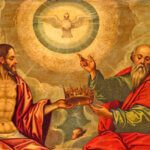The biblical tale of Cain’s murder of his brother Abel is universally recognized, whether you’re a Bible scholar or not. We all understand that Cain was responsible for Abel’s demise, but what transpired after that? Join us as we closely examine his penalty, the sign God placed upon Cain, and what the Scripture subsequently reveals about his fate.
What Was Cain’s Punishment for Killing Abel?
First, let’s take a look at the punishment God hands down to Cain.
In the Bible, Cain’s killing of Abel (who was probably not his twin) is a profound transgression. Although God’s subsequent judgment in Genesis 4:11-12 might seem lenient, its weight is severe. For Cain, the punishment, which stripped him of his livelihood as a tiller of the ground and forced him into a life of wandering, felt more burdensome than death itself (Genesis 4:13). In addition to this, fearing retribution, God marked Cain for protection, though the nature of this mark remains enigmatic.

God’s leniency might have had larger plans in mind. Cain’s descendants, as documented, made significant contributions, albeit with some following Cain’s violent tendencies. While some speculate that the early human population’s sparsity prevented Cain’s execution, the Bible doesn’t provide definitive answers – as it also doesn’t let us know exactly how old Abel was when Cain killed him. What’s evident is Cain’s eventual marriage and city foundation, hinting at a growing world population from Adam and Eve’s other offspring.
Only in the later Noahic Covenant did murder warrant capital punishment (Genesis 9:6), further solidified by the Mosaic Law (Numbers 35:30-31, 33). Cain’s punishment was both fitting for his era and a testament to God’s enduring justice.
What Mark Did God Put on Cain in Genesis 4:15?
Then the Lord said to him, “Not so! If anyone kills Cain, vengeance shall be taken on him sevenfold.” And the Lord put a mark on Cain, lest any who found him should attack him.
Genesis 4:15
The exact nature of Cain’s mark has long been a topic of discussion. The Hebrew term for “mark” in this context, ‘owth, typically means “sign.” However, its use in the tale of Cain doesn’t specify the mark’s nature. The main point is that the mark protected Cain from retaliation. While some suggest it might have been a scar or tattoo, the text doesn’t confirm this.
Let’s back up a bit though. It’s important to note that God gives him this mark initially because Cain thinks someone might find him and kill him.
Today you are driving me from the land, and I will be hidden from your presence; I will be a restless wanderer on the earth, and whoever finds me will kill me.
Genesis 4:14
We don’t know exactly who Cain was afraid of – it may have just been a general declaration.
Historically, some wrongly asserted that the mark was dark skin, and erroneously tied it to a curse. This flawed interpretation was used to justify discrimination and even the African slave trade. However, the Hebrew term ‘owth has no reference to skin color. The curse was specific to Cain and not inheritable. Also, since Cain’s lineage likely ended with the Great Flood, his descendants wouldn’t carry the mark.
In essence, the Bible is silent about the mark’s specific appearance. Its significance lies in its protective function for Cain, not in its physical characteristics. Any attempt to link the mark with skin color or use it to validate discrimination goes against biblical teachings.
What Happened to Cain Next?
The Bible doesn’t tell us much about Cain’s life following his punishment. We know that Cain marries a wife who gives birth to Enoch. And we know that he no longer worked as a farmer, but was left to wander the earth.
But that’s about all we know. He likely felt some shame and guilt over the murder of his brother. He bore the Lord’s punishment, and likely lived a very long life (as one did at that time) with his family before his death.





